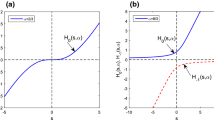Abstract
The evaluation of drugs in vivo is often based on experimental models using small animals such as mice, rats and rabbits. However, these models could be improved to correspond more closely to the human situation if the pharmacokinetics of the drugs tested in animals were similar to that observed in humans. The use of a computer-controlled pump allowing an adequate flow of tobramycin and amikacin to be infused into rabbits enabled us to simulate the human pharmacokinetics of these antibiotics in vivo in this study. The function defining the rate of infusion required to perform the simulation of an intravenous bolus was first determined generally and symbolically for linear pharmacokinetic models independently from the number of compartments involved. The practical simulation of a decreasing monoexponential serum profile with a half-life of 2 h (one-compartment model for the human pharmacokinetics of aminoglycosides) was then studied for tobramycin and amikacin on the basis of a two-compartment model in the animal. The kinetics obtained had an apparent elimination half-life of 1.97 and 1.86 h, respectively. Linearity of the semilogarithmic regressions of the profiles obtained was quite sound. Finally, an a posteriori analysis of the pharmacokinetic model and its parameters is proposed on the basis of the results obtained after simulation.
Similar content being viewed by others
References
Bard, Y. (1974). Interpretation of the estimates, in Non linear parameter estimation, New York: Academic Press, pp. 170–217.
Boxenbaum, H. (1982). Interspecies scaling, allometry, physiological time, and the ground plan of pharmacokinetics. J. Pharmacokin. Biopharmacol. 10, 201–227.
Bugnon, D., G. Potel, Y. Q. Xiong, J. Caillon, M. F. Kergueris, P. Le Conte, D. Baron, and H. Drugeon (1996). In vivo antibacterial effects of simulated human serum profiles of once-daily versus thrice-daily dosing of amikacin in a serratia marcescens endocarditis experimental model. Antimicrobiol. Agents Chemother. 40, 1164–1169.
Craig, W. A., J. Redington and S. C. Ebert (1991). Phamacodynamics of amikacin in vitro and in mouse thigh and lung infections. J. Antimicrobiol. Ther. 27(Suppl. C), 29–40.
Fantin, B., S. Ebert, J. Leggett, B. Vogelman and W. A. Craig (1990). Factors affecting duration of in-vivo postantibiotic effect for aminoglycosides against gram-negative bacilli. J. Antimicrobiol. Ther. 27, 829–836.
Fluckiger, U., P. Moreillon, J. Blaser, M. Bickle, M. P. Glauser and P. Francioli (1994). Simulation of amoxicillin pharmacokinetics in humans for the prevention of streptococcal endocarditis in rats. Antimicrobiol. Agents Chemother. 38, 2846–2849.
Gerber, A. U., H. P. Brugger, C. Feller, T. Stritzko and B. Stalder (1986). Antibiotic therapy of infections due to pseudomonas aeruginosa in normal and granulocytopenic mice: comparison of murine and human pharmacokinetics. J. Infect. Dis. 153, 90–97.
Jolley, M. E., S. D. Stroupe, C. H. J. Wang, H. N. Panas, H. L. Keegan, R. L. Schmidt and K. S. Schwenzer (1981). Fluorescence polarization immunoassay. I. Monitoring aminoglycoside antibiotics in serum and plasma. Clin. Chem. 27, 1190–1197.
Leggett, J. E., B. Fantin, S. Ebert, K. Totsuka, B. Vogelman, W. Calame, H. Mattie and W. A. Craig (1989). Comparative antibiotic dose-effect relations at several dosing intervals in murine pneumonitis and thigh-infection models. J. Infect. Dis. 159, 281–292.
Lindstrom, M. J. and D. M. Bates (1988). Newton-Raphson and EM algorithms for linear mixed-effects models for repeated-measures data. J. Am. Stat. Assoc. 83, 1014–1022.
Lindstrom, M. J. and D. M. Bates (1990). Nonlinear mixed effects models for repeated measures data. Biometrics 46, 673–687.
Mordenti, J. (1986). Man versus beast: pharmacokinetic scaling in mammals. J. Pharm. Sci. 75, 1028–1040.
Potel, G., J., Caillon, F. Le Gallou, D. Bugnon, P. Le Conte, J. Raza, J. Y. Lepage, D. Baron and H. Drugeon (1992). Identification of factor affecting in vivo aminoglycoside activity in an experimental model of gram-negative endocarditis. Antimicrobiol. Agents Chemother. 36, 744–750.
Van den Berg, C. L., J. R. McGill, J. G. Kuhn, J. T., Walsh, P. S. De la Cruz, K. K. Davidson, G. M. Wahl and D. D. Von Hoff (1994). Pharmacokinetics of hydroxyurea in nude mice. Anticancer Drugs, 5, 573–578.
Author information
Authors and Affiliations
Corresponding author
Rights and permissions
About this article
Cite this article
Bugnon, D., Potel, G., Caillon, J. et al. In vivo simulation of human pharmacokinetics in the rabbit. Bull. Math. Biol. 60, 545–567 (1998). https://doi.org/10.1006/bulm.1997.0013
Received:
Accepted:
Issue Date:
DOI: https://doi.org/10.1006/bulm.1997.0013




